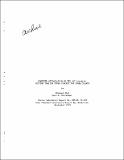| dc.description.abstract | There is a projected water shortage problem in the electrical power
industry by the end of this century. Dry and wet-dry cooling towers are
going to be the solution of this problem. Our previous study on the
combination of separate dry and wet cooling towers indicated that wet-dry
cooling is an economical choice over all-dry cooling when some water is
available but the supply is insufficient for an evaporative tower. An
advanced wet-dry cooling tower concept was experimentally studied at
MIT's Heat Transfer Laboratory and a computer model was developed for
predicting the performance of this cooling concept. This study has
determined the cost of the cross-flow type of this cooling concept in
conjunction with steam electrical power plants. Aluminum is found to be
economically preferable to galvanized steel as the cooling plate material.
In our base case study using aluminum plates for a 1094 MWe nuclear plant
at Middletown, the MIT advanced cooling concept is comparable to conventional
wet-dry towers at water makeups larger than 45% and is slightly more
economical at makeup larger than 50%. The incremental costs over the power
production cost, 32.3 mills/Kwhr, of zero condenser system are 14, 13 and
12 percent for makeups of 45, 60 and 55 percent, respectively. For an 800
MWe fossil plant at Moline, this cooling concept is more economical than
conventional wet-dry towers at water makeups larger than 27%. The incremental
costs over 20.8 mills/Kwhr of zero condenser system are 12.2 and 10.6
percent for makeups of 37 and 50 percent, respectively. For these two
makeups, going from conventional wet-dry to MIT advanced concept results in
13 and 21 percent, respectively, savings in the incremental cost. When
the water makeup exceeds 30%, the MIT advanced wet-dry concept is pre-
ferable to conventional wet-dry towers for a 1200 MWe nuclear plant at
Moline, Ill. The incremental costs over zero condenser system of 21.1 mills/
Kwhr are 12.8 and 11.5 percent for makeups of 40 and 50 percent, respectively.
Using the MIT advanced concept instead of conventional wet-dry towers
results in 28 and 33 percent reduction of incremental power production
cost for these two makeups, respectively. | en |
